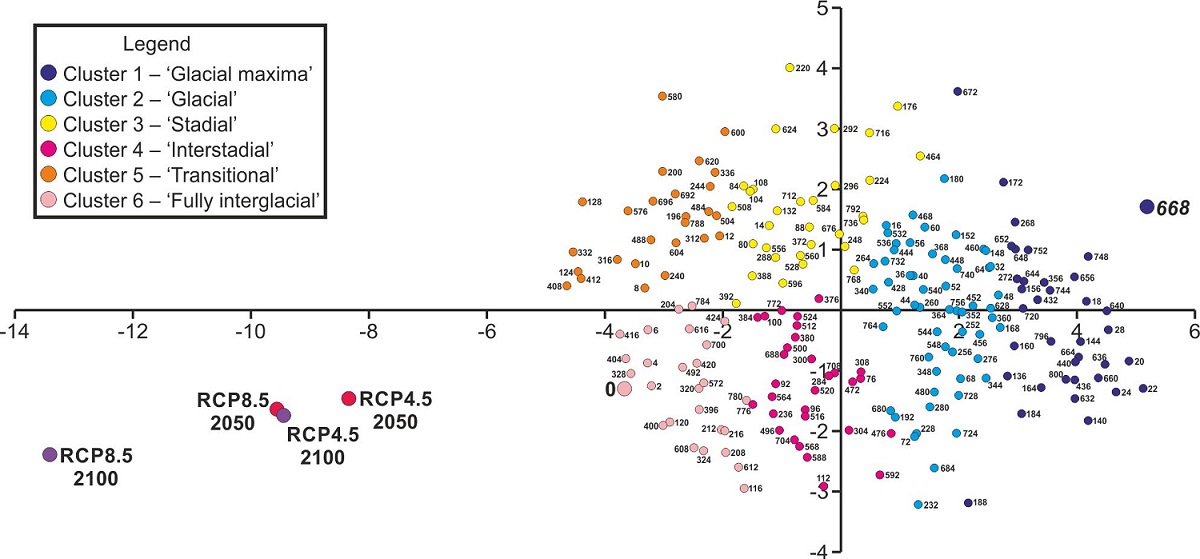Global biome patterns of the Middle and Late Pleistocene

A newly published study led by Emeritus Professor Brian Huntley shows the key role that atmospheric carbon dioxide concentration has played in past changes in global vegetation patterns, provides evidence that past biome extent plays a key role in determining present patterns of biodiversity, and demonstrates that potential future global vegetation patterns are unlike any during the past 800,000 years.
Our primary aim was to assess the hypothesis that distinctive features of the patterns of vegetation change during successive Quaternary glacial–interglacial cycles reflect climatic differences arising from forcing differences. We addressed this hypothesis using 207 half-degree resolution global biome pattern simulations, for time slices between 800 ka and 2 ka, made using the LPJ-GUESS dynamic global vegetation model. Simulations were driven using ice-core atmospheric CO2 concentrations, Earth’s obliquity, and outputs from a pre-industrial and 206 palaeoclimate experiments; four additional simulations were driven using projected future CO2 concentrations. Climate experiments were run using HadCM3. Using a rule-based approach, above-ground biomass and leaf area index of LPJ-GUESS plant functional types were used to infer each grid cell’s biome. The hypothesis is supported by the palaeobiome simulations.
To enable comparisons with the climatic forcing, multivariate analyses were performed of global vegetation pattern dissimilarities between simulations. Results showed generally similar responses to glacial–interglacial climatic variations during each cycle, although no two interglacials or glacials had identical biome patterns. Atmospheric CO2 concentration was the strongest driver of the dissimilarity patterns. Dissimilarities relative to the time slice with the lowest atmospheric CO2 concentration show the log–linear relationship to atmospheric CO2 concentration expected of an index of ecocarbon sensitivity.
For each simulation, extent and total above-ground biomass of each biome were calculated globally and for three longitudinal segments corresponding to the major continental regions. Mean and minimum past extents of forest biomes, notably Temperate Summergreen Forest, in the three major continental regions strongly parallel relative tree diversities, hence supporting the hypothesis that past biome extents played an important role in determining present diversity.
Albeit that they reflect the climatic consequences only of the faster Earth system components, simulated potential future biome patterns are unlike any during the past 800 ky, and likely will continue to change markedly for millennia if projected CO2 concentrations are realised.
Figure: Non-metric multidimensional scaling analysis of global biome pattern dissimilarities, including projected future biome patterns
Plot of non-metric multidimensional scaling axis 1 (horizontal) versus axis 2 (vertical) for an analysis including the potential future biome patterns for 2050 and 2100 under the RCP4.5 and RCP8.5 concentration pathways, as well as all past time slices. Each point represents a time slice or potential future and is labelled with its age (ka) or concentration pathway and year (CE). Points representing past time slices are coloured to indicate to which of the six clusters, identified using K-Means cluster analysis, they belong: cluster 1 – blue; cluster 2 – cyan; cluster 3 – yellow; cluster 4 – magenta; cluster 5 – orange; cluster 6 – pink. Points representing potential future biome patterns are coloured red for 2050 projections and purple for 2100 projections.
Further Information:
Find out about more about the Department of Biosciences
Read the full article here: https://onlinelibrary.wiley.com/doi/full/10.1111/jbi.14619

